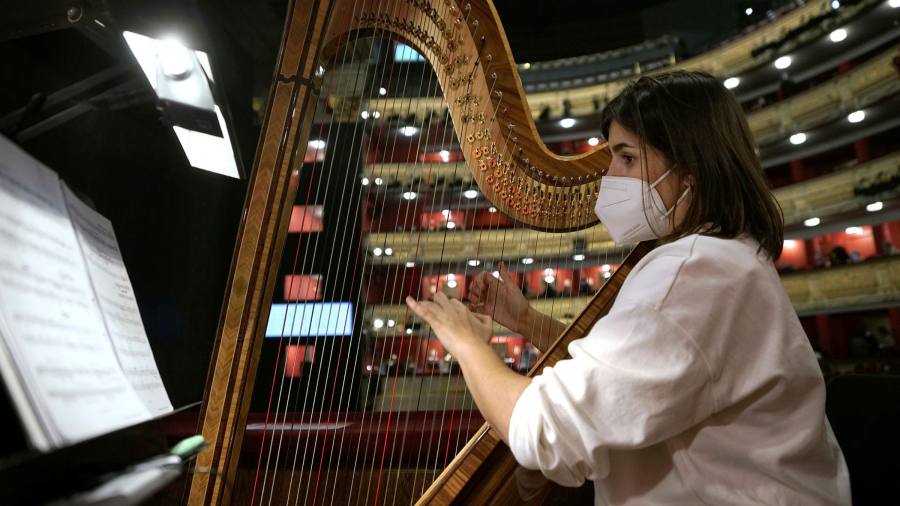[ad_1]
Madrid’s Teatro Real opera house is busy preparing its latest productions in what at any time would be an ambitious season. With Spain battling some of Europe’s worst coronavirus infection rates, its plans are all the more remarkable.
The Real’s premiere of a production of Wagner’s four hour-long Siegfried takes place on Saturday while two other operas with largely foreign casts — Bellini’s Norma and Britten’s Peter Grimes — will be staged this month.
The performances are part of a flurry of artistic activity that has continued in the Spanish capital despite the pandemic, as Madrid gives its answer to the question: how much should cultural life be closed down to keep the virus in check?
“It’s really fantastic to be able to work,†enthused Robert Carsen, Siegfried’s Canadian director. “The rest of Europe is almost entirely closed, theatres are struggling, artists are struggling, and it’s really incredible to be able to work in the theatre in these fantastic conditions.â€Â
Madrid’s artistic activity goes well beyond the Real. Some 90 per cent of the city’s 60-odd theatres are giving performances — just about the only productions on hold are musicals.
The city’s great museums — the Prado, Thyssen-Bornemisza and Reina SofÃa — are open, as are many smaller galleries. This month the capital even hosts the Madrid Design Festival, featuring more than 150 in-person exhibitions and events at dozens of venues, including a “food experience†at Michelin-starred chef Diego Guerrero’s restaurant DSpeak.
The Real has been open since July, just after Spain’s tough spring lockdown, with only a few tweaks to a programme planned years in advance. “The word is ‘heroic’,†said Pablo Heras-Casado, Siegfried’s conductor, who has been working for months on how to reposition the 87-piece Wagnerian orchestra.
To maintain social distancing, nine brass players have been banished to boxes to the right of the stage; six harps and a percussionist are on the opposite side; several violinists play jammed against the wall.
It is not exactly what Wagner had in mind when he developed the orchestra pit in the 1870s, to hide musicians out of sight. But it is emblematic of Madrid’s determination to keep cultural life alive — and live — during the depths of the pandemic.
The Real has taken a host of other measures. Everyone is regularly tested for the virus and wardrobe and make-up are attended to in corridors or rehearsal rooms, to keep the cast apart. The audience is masked and their temperatures are taken on arrival. Nuria Gallego, Real’s director of infrastructure, said the ventilation system pumped out a minimum of 28 litres of filtered air for each member of the audience every second.
There have been mishaps. The opera house was forced to cancel a performance of Verdi’s Un ballo in maschera in September after audience members protested at what they saw as inadequate social distancing in the cheaper seats.
But the Real maintains it has followed the rules set by the Madrid region — which allows it to fill about two-thirds of its 1,746 seats — and that there has not been a single documented case of infection at the opera.
“We don’t know how much cultural activities contribute to transmission — it’s extremely hard to compare the effectiveness of different countries’ regimes — and they can make a useful contribution to mental health,†said Pedro Alonso, professor of global health at Barcelona university.
But the policy in much of Europe has been to close down live performances with audiences. While Moscow has taken a similar approach to Madrid, ending a six month-long shutdown of cultural venues with a September performance of Verdi’s Don Carlos at the Bolshoi, London’s West End is closed.
Museums, theatres and cinemas across France have been shut since October — although commercial art galleries remain open. The Vienna Philharmonic played its annual New Year’s Day concert to an empty hall for the first time since the tradition began in 1939.
One difference is that Spain’s Socialist-led government was fiercely attacked by political foes and regional leaders for imposing a harsh lockdown between March and June. Perhaps as a result, it has issued no second stay-at-home order even as infection rates have risen to the third highest in the EU.Â
Instead, prime minister Pedro Sánchez has passed primary responsibility for handling the pandemic to the regions, giving them powers to limit people’s movements, operate curfews and restrict gatherings.
Spain’s infection rate has been falling for about two weeks. But as of this week, the rate is twice that of France and more than four times Germany’s.
Amid the patchwork of restrictions across the country, Madrid’s centre-right administration has been among the most reluctant to impose curbs, whether on hospitality or the arts.
Other regions have been more wary. The Picasso museum in Málaga is closed, as is the Dalà Theatre-Museum in Figueres, although the Guggenheim Museum in Bilbao is open and Barcelona’s Miró foundation is operating at a limited schedule around the weekends.Â
The national government favours opening up such spaces if possible.
“We’ve seen that cultural spaces can be safe — without infection — as long as strict protocols are followed and masks are worn,†said José Manuel RodrÃguez Uribes, Spain’s arts minister. “Culture has helped us get through these difficult months . . . Culture is a basic human right.â€
Additional reporting by Henry Foy in Moscow, Valerie Hopkins in Budapest and Victor Mallet in Paris
[ad_2]
Source link








